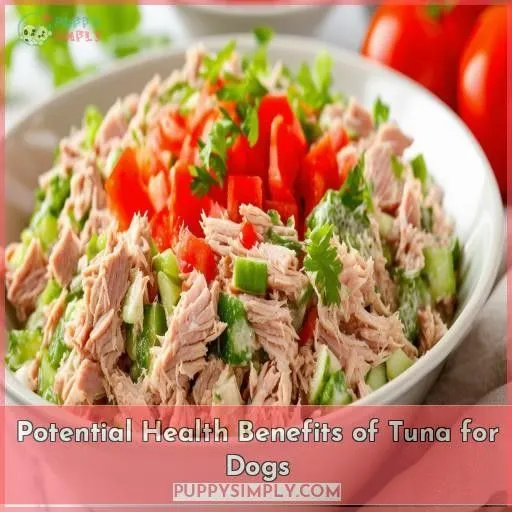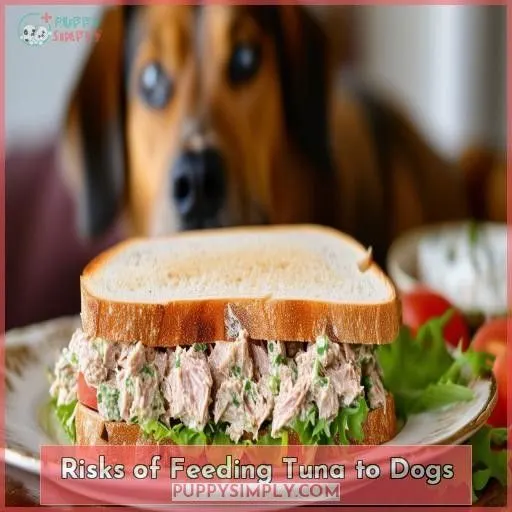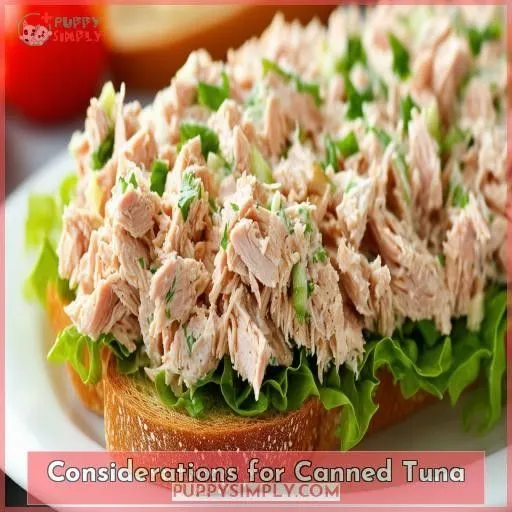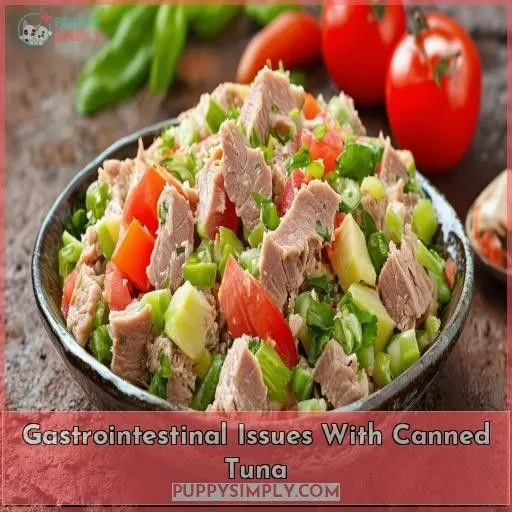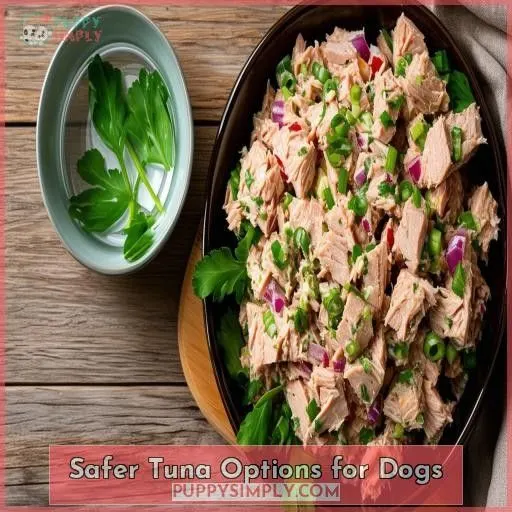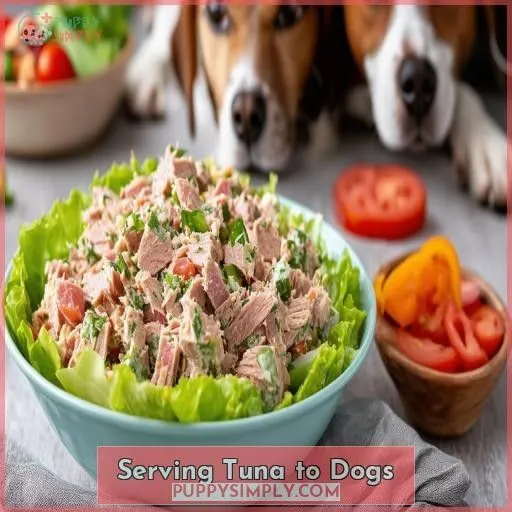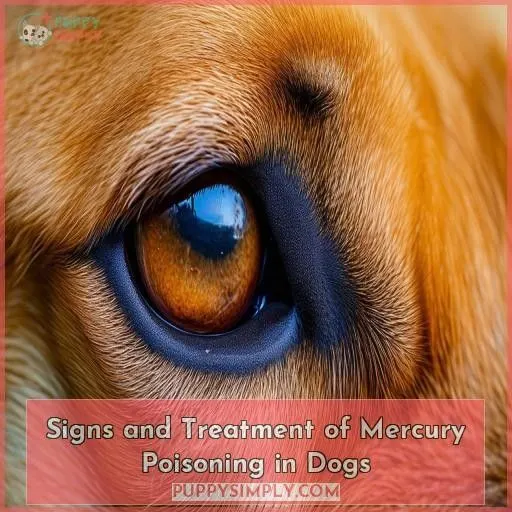This site is supported by our readers. We may earn a commission, at no cost to you, if you purchase through links.
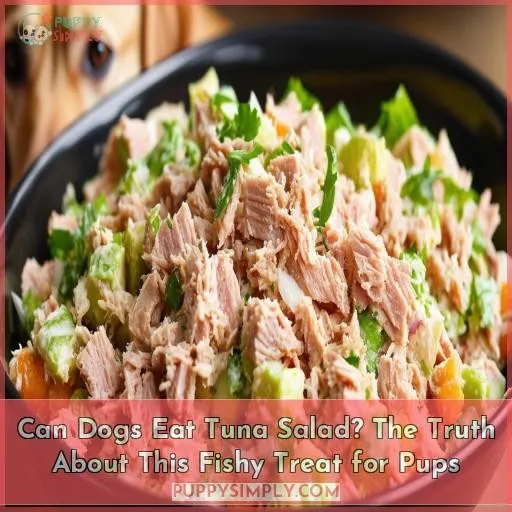
Mercury poisoning and high salt content are also risks. Instead, stick to Plain, unseasoned tuna as an occasional treat, in small amounts. Always monitor your dog for any adverse reactions.
Curious about safer and healthier ways to share tuna with your dog, as well as signs of mercury poisoning to watch for? Keep exploring to guarantee your pup’s safety and health.
Table Of Contents
- Key Takeaways
- Can Dogs Eat Tuna Salad?
- Tuna as a Treat for Dogs
- Potential Health Benefits of Tuna for Dogs
- Risks of Feeding Tuna to Dogs
- Considerations for Canned Tuna
- Gastrointestinal Issues With Canned Tuna
- Safer Tuna Options for Dogs
- Why Tuna Salad is Not Recommended for Dogs
- Serving Tuna to Dogs
- Signs and Treatment of Mercury Poisoning in Dogs
- Frequently Asked Questions (FAQs)
- Conclusion
Key Takeaways
- Tuna Salad: Not a Picnic for Pups: It’s a no-go zone for your furry friend due to harmful ingredients like mayo and onions. Stick to plain, unseasoned tuna instead.
- Tuna Treat: A Tail-Wagging Delight: Offer tuna as an occasional treat, but keep it small and unseasoned. It’s a tasty way to boost their protein and omega-3 intake.
- Mercury Mischief: Watch for the Signs: Keep an eye out for symptoms like vomiting blood or tremors after tuna consumption. If you spot any, rush to the vet – it could be mercury poisoning.
- Safer Tuna Choices: Reel in the Goodness: Opt for plain, unseasoned tuna packed in water. Avoid canned tuna with added oils or salt, and keep portions small to prevent tummy troubles.
Can Dogs Eat Tuna Salad?
No, dogs shouldn’t eat tuna salad. Tuna salad often contains mayonnaise and seasonings that can be harmful to dogs .
Tuna as a Treat for Dogs
When it pertains to giving your pup a fishy treat, tuna can be a tasty option. But before you start dishing out the tuna salad, let’s delve into the details.
Tuna is a great source of protein and omega-3 fatty acids, but it’s important to keep an eye on the quantity and frequency. Some dogs may have a tuna sensitivity, so it’s best to introduce it slowly and watch for any adverse reactions.
When storing tuna, make sure it’s in an airtight container and consumed within a few days.
If you’re not sure about feeding your furry friend tuna, consider alternative fish options or consult with your vet. After all, your pup’s health is the top priority!
Potential Health Benefits of Tuna for Dogs
While tuna can offer some health benefits for dogs, it’s crucial to acknowledge the risks. Tuna is a good source of protein and omega-3 fatty acids, but it also poses potential dangers like mercury poisoning, parasites, and choking hazards from fish bones.
Good Source of Protein
While tuna can be a tasty treat for your pup, it’s also an excellent source of protein. This lean fish delivers a powerful boost to your dog’s muscles and energy levels. Just be sure to choose high-quality, low-sodium canned tuna to avoid any digestive issues or allergic reactions. Moderation is key for this protein-rich snack!
Omega-3 Fatty Acids
Tuna contains omega-3 fatty acids that support your pup’s cardiovascular health, brain development, and immune system. These beneficial fats also have anti-inflammatory properties. However, the mercury content in tuna can lead to poisoning if consumed in excess. While sharing human food with your furry friend is tempting, it’s essential to prioritize their safety and well-being.
Risks of Feeding Tuna to Dogs
While tuna can provide some health benefits for dogs, it also comes with significant risks. Mercury poisoning, parasites or microbes from raw tuna, and fish spines as choking hazards are all potential dangers to keep in mind when considering feeding tuna to your furry friend.
Mercury Poisoning
While tuna offers protein benefits, it also carries risks. Mercury levels can accumulate in your pup’s system over time from regular fish consumption, potentially leading to long-term health issues. To minimize this risk and environmental impact, consider these dietary alternatives:
- Plain, cooked chicken
- Turkey
- Other low-mercury fish
Parasites or Microbes From Raw Tuna
Raw tuna can harbor parasites (寄生虫传播) and microbes (微生物感染) that may lead to food poisoning (食物中毒). These pathogens, coupled with potential nutritional imbalances (营养不平衡) and allergic reactions (过敏反应), make uncooked tuna a risky treat for your furry friend. Stick to cooked tuna instead!
Fish Spines as Choking Hazards
Another risk to keep in mind is that fish spines can pose a serious choking hazard for dogs. When feeding your pup tuna, be sure to:
- Remove all bones and spines
- Flake the fish into small pieces
- Supervise your dog while eating
- Watch for signs of choking or distress
- Contact your vet immediately if issues arise
Considerations for Canned Tuna
When considering canned tuna for your dog, pay attention to the salt content and opt for low-sodium varieties. It’s also best to avoid canned tuna with added preservatives and oils, as these can lead to gastrointestinal issues like upset stomach or even pancreatitis.
Salt Content
When feeding Fido canned tuna, watch out for high salt content. Too much sodium can lead to tuna poisoning or even mercury poisoning. Stick to low-salt varieties and limit serving sizes to keep your pup’s salt intake in check.
Low-sodium Varieties
If you opt for canned tuna, choose low-sodium varieties to minimize salt intake. Look for labels that say:
- "No Salt Added"
- "Low Sodium"
- "Reduced Sodium"
Too much salt can lead to dehydration and electrolyte imbalances in dogs.
Avoid Added Preservatives and Oils
Not just should you opt for low-sodium varieties, but also steer clear of canned tuna with added preservatives and oils. These extras can pose health risks for your pup.
| Ingredient | Purpose | Potential Harm |
|---|---|---|
| Preservatives | Extend shelf life | Upset stomach, allergies |
| Oils | Flavor, texture | Pancreatitis, weight gain |
Stick to plain, water-packed tuna to keep your furry friend safe and healthy.
Gastrointestinal Issues With Canned Tuna
While canned tuna may seem like a convenient treat for your pup, it can lead to some unpleasant gastrointestinal issues. The added oils in many canned tuna products can cause an upset stomach or even pancreatitis in dogs.
Upset Stomach
When feeding your pup canned tuna, watch out for upset tummies! The high salt content can lead to digestive woes like vomiting and diarrhea. To keep Fido’s belly happy, opt for low-sodium varieties and skip the ones with added preservatives or oils. Stick to tuna packed in water for a safer, gentler treat that won’t cause gastrointestinal distress.
Pancreatitis From Added Oils
In addition to the possibility of causing an upset stomach, the added oils in canned tuna can also contribute to pancreatitis in some dogs.
Pancreatitis is a severe digestion issue that can arise from excessive fat consumption, such as the oils commonly used in canned tuna.
To prevent this potentially serious health issue for your pup, opt for tuna packed in water.
Safer Tuna Options for Dogs
If you want to offer your dog a safer tuna treat, opt for canned tuna packed in water rather than oil. Choose plain, unseasoned varieties to avoid any potential gastrointestinal upset or toxic ingredients often found in seasoned or flavored tuna products.
Canned Tuna Packed in Water
If you’re concerned about the added oils and preservatives in canned tuna, opt for varieties packed in water instead. The water-packed tuna is a safer choice for your pup, as it minimizes the risk of gastrointestinal issues like upset stomach or even pancreatitis. When selecting canned tuna for your dog, always check the label to verify it’s packed in water.
Plain, Unseasoned Tuna
If you want to feed your pup tuna, opt for plain, unseasoned varieties. Canned tuna packed in water is a safer choice. When serving tuna to your furry friend, remember:
- Quality matters – choose reputable brands
- Portion control is key – offer small amounts
- Moderation is essential – limit tuna treats
- Watch for allergic reactions or digestive issues
Why Tuna Salad is Not Recommended for Dogs
While tuna itself can be a healthy treat for dogs in moderation, tuna salad isn’t recommended. The mayonnaise in tuna salad adds unnecessary calories and fat, while seasonings like onion or garlic can be toxic to dogs.
Mayonnaise Adds Unnecessary Calories
When considering safer tuna options for dogs, understanding why tuna salad isn’t recommended is crucial. Mayonnaise, often found in tuna salad, adds unnecessary calories, posing health concerns. It doesn’t benefit your dog’s nutrition and can contribute to weight gain or obesity. Opt for plain, unseasoned tuna packed in water instead to maintain their health.
Seasonings Can Be Toxic or Harmful
Seasonings in tuna salad aren’t safe for dogs. Ingredients like onion and garlic powder, which are common in such dishes, can lead to allergic reactions or gastrointestinal distress. Additionally, spices can cause dental issues due to their abrasive textures. Tuna salad’s flavor enhancements pose serious health risks for your furry friend, making it a poor choice.
Serving Tuna to Dogs
Serving tuna to your dog can be beneficial when done correctly. Offer it as an occasional treat to entice eating or to boost their omega-3 intake, but always use plain, unseasoned tuna in small amounts.
As an Occasional Treat
Feeding your dog tuna as an occasional treat can be rewarding. Here’s how to do it safely:
- Opt for small, controlled tuna amounts.
- Avoid raw tuna to dodge parasites.
- Skip additives like salt and oils.
- Confirm it’s plain, unseasoned tuna.
To Entice Eating or Increase Omega-3 Intake
To boost your dog’s omega-3 intake and entice picky eaters, consider plain tuna. It’s a tasty treat, but mindful of health risks, use safe alternatives like salmon or chia seeds.
| Option | Omega-3 Benefits | Health Risks |
|---|---|---|
| Tuna | High | Mercury poisoning |
| Salmon | High | Low |
| Chia Seeds | Moderate | None |
| Flaxseeds | Moderate | None |
| Sardines | High | Low |
In Small Amounts as a Snack
To entice eating or increase omega-3 intake, serve tuna in small amounts as a snack. Here’s how:
- Ensure it’s plain and unseasoned.
- Offer tuna occasionally to avoid health concerns.
- Monitor dog safety and pet nutrition closely.
Signs and Treatment of Mercury Poisoning in Dogs
If you notice symptoms like vomiting blood, tremors, or loss of coordination after your dog eats tuna, seek veterinary care immediately. To avoid these risks, opt for safer alternatives like plain, unseasoned chicken, cooked fish, or turkey (Source).
Seek Veterinary Care Immediately if Symptoms Appear
If you suspect mercury poisoning in your dog from eating tuna, seek veterinary care immediately. Look for symptoms like vomiting blood, tremors, loss of coordination, anxiety, and blindness. These symptoms indicate severe toxicity, and only prompt treatment can prevent further harm. Always be proactive in recognizing and addressing your dog’s health issues quickly.
Safer Alternatives: Plain, Unseasoned Chicken, Cooked Fish, or Turkey
If you’re worried about mercury poisoning from tuna, consider safer alternatives with high nutritional value and easier portion control. Plain, unseasoned chicken, cooked fish, or turkey are excellent choices.
- Tuna substitutes: Chicken, fish, turkey
- Cooking methods: Plain, unseasoned, cooked
- Portion control: Small amounts
- Feeding frequency: Occasional treats only
Frequently Asked Questions (FAQs)
How much tuna can a dog safely eat?
Curious how much tuna your dog can safely enjoy? Just a small amount, as a snack, will suffice. Too much can lead to mercury poisoning—stick to a few bites of plain, unseasoned tuna for a tasty treat.
Can puppies eat tuna?
Puppies can eat plain, unseasoned tuna in small amounts as a treat. Avoid raw tuna due to parasites and mercury poisoning risks. Opt for tuna packed in water, not oil, and make certain it’s low-sodium .
Is it okay to mix tuna with dog food?
Yes, you can mix tuna with dog food in small amounts. Always use plain, unseasoned tuna packed in water, ensuring it’s low-sodium. Avoid using tuna frequently to minimize the risk of mercury exposure.
Are there any dog-safe tuna recipes?
You can whip up a dog-safe tuna casserole, a veritable feast of omega-3s and protein, by using plain, unseasoned tuna, cooked rice, and vegetables. Avoid canned tuna with added oils or salt (Source).
Can dog breeds show different reactions to tuna?
Different dog breeds can show various reactions to tuna due to potential allergies, size, and health conditions like mercury poisoning or gastrointestinal upset. Always monitor your dog closely when introducing tuna to their diet (Source).
Conclusion
Importantly, while tuna can be beneficial for dogs in moderation, it’s imperative to avoid feeding them tuna salad. The added ingredients like mayonnaise and onions can be harmful.
Stick to plain, unseasoned tuna, and always watch for signs of mercury poisoning. Feeding tuna safely enhances your dog’s diet with protein and omega-3s.


